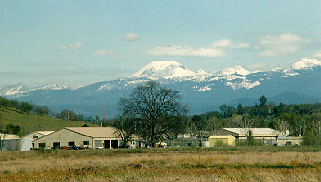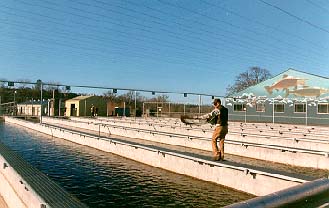

 |
 |
|
Coleman National Fish Hatchery
![]()
Text from Coleman National Fish Hatchery
| The Coleman NFH was constructed in 1942 as part of the mitigation measures to help preserve significant runs of Chinook salmon threatened by the 'loss of natural spawning areas resulting from the construction of Shasta Dam on the Sacramento River. Construction of the facility was authorized as an integral part of the Central Valley Project (CVP). The CVP was authorized and established under the provisions of the Emergency Relief Appropriation Act of 1935 (49 Stat.115) and the First Deficiency Appropriation Act, Fiscal Year 1936 (49 Stat.1622). The River and Harbor Act of 1937 (50 Stat.844,850) reauthorized the CVP for con- struction by the Secretary of the Interior and subject to the Reclamation laws. Reference to fish and wildlife protection aspects of the CVP were in the October 17, 1940 (54 Stat.1198,1199) legislation. Total cost for the hatchery and Keswick Fish Trap was $2,013,750. |  |
 |
Four salvage plans were proposed by the U. S. Fish and Wildlife Service for salvaging the runs of Sacramento River salmon blocked by Shasta Dam. A board of consultants (appointed by the Bureau of Reclamation (Bureau)) recommended one of these plans called the "Sacramento River, Battle Creek, Deer Creek Plan" which the Bureau accepted. Objectives of the Plan were to 1) ensure proper distribution of salmon in the river for natural spawning, 2) reduce spring Chinook losses in the main river due to high water temperatures while Shasta Lake filled, 3) release young salmon from hatcheries in accord with the natural migration period, and 4) continue studies of artificial propagation. |
1. Transfer of 10,000 spring Chinook salmon to Deer Creek for natural propagation;
2. Transfer of 2,000 spring Chinook salmon to Battle Creek for artificial propagation;
3. Transfer of 18,000 summer and early fall Chinook to Battle Creek for artificial propagation; and
4. Distribution of 30,000 fall Chinook in the Sacramento River by installing three racks to control salmon migration.
To carry out this plan, the Bureau agreed to provide the following:
1. A fish ladder, trap, and lift at Keswick Dam and at Balls Ferry rack.
2. Seven 1,000-gallon capacity fish tank trucks.
3. A hatchery on Battle Creek with the capacity for 58,000,000 eggs or advanced fry, and 29,000,000 fingerlings, and appurtenant ponds, cold storage facilities and buildings.
4. Five racks in Battle Creek to form four holding and ripening pools for adult spring salmon transferred from the Sacramento River.
5. Three racks across the Sacramento River.
6. A fishway around the lower falls on Deer Creek to make accessible an additional five miles of spawning gravel.
Two hatcheries on Battle Creek participated in these operations, the old Battle Creek Hatchery near the mouth of Battle Creek which was closed after the 1944 season, and the new Coleman Station located approximately 6 miles upstream from the Sacramento River which began operation in 1943.
All the agreed upon plans
were not carried out for various reasons, and the salvage goals were only partially
realized. Only two racks were installed in the Sacramento River, and these failed
to function properly. The total salmon population allowed to spawn in the river
between Balls Ferry and Keswick Dam was much greater than planned. Mortality
of spring Chinook transferred to Deer Creek was high and the ultimate success
of this operation appeared quite dubious. Mortality of adult spring Chinook
salmon transferred to Battle Creek was also high, pri- primarily because of
warm water temperatures. Propagation of spring Chinook salmon at Coleman was
subsequently suspended.
 |
By 1946, none of the racks in the Sacramento River were operating and trapping of spring Chinook at Keswick had ceased. Hatchery operations at the Coleman Station were considered successful except for the problem of holding adult spring Chinook until ready for spawning. It was concluded that the spring run of salmon was more likely to be perpetuated if left undisturbed in the Sacramento River as ecological con- conditions (temperature and flow) below Shasta Dam were satisfactory. The only remaining Federally operated elements of the Shasta Salmon Maintenance Plan are the Coleman hatchery and the Keswick Fish Trap. In 1949 a Memorandum of Agreement was signed between the Bureau and the Service pertaining to the custody and future operation of the Coleman Hatchery and other fishery maintenance facilities of the upper Sacramento River, including Keswick Fish Trap. Since July 1, 1949, the Service has assumed all annual operation, maintenance and replacement costs at the Coleman Hatchery. The Keswick Fish Trap is operated by the Service and is maintained by the Bureau in conjunction with other facilities at Keswick Dam in accordance with a 1951 Memorandum of Agreement. |